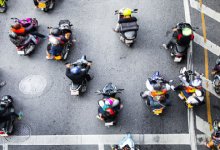
Here are some tips riders should take note to ensure safer roads during heavy downpours

The Philippine Atmospheric, Geophysical, and Astronomical Services Administration (PAGASA) recently announced the arrival of the rainy season. This brings challenging conditions for motorcycle riders, including slippery roads and reduced visibility, making riding even more difficult and hazardous.
In line with its mission to promote safer roads in the country, the Motorcycle Development Program Participants Association, Inc. (MDPPA) shares some crucial tips for riders to prepare before every ride during the rainy season.
Invest in high-quality and suitable gear. In addition to the standard equipment required for riding a motorcycle, such as a helmet, it is essential to invest in a high-quality riding jacket, pants, shoes, and gloves to keep yourself dry. Riders can also opt for reflectorized rain gear, including raincoats and rain pants, to enhance visibility on the road during heavy rain. Upgrading the helmet with an anti-fog visor insert can prevent fogging and provide clearer vision. Non-slip riding shoes that offer waterproof protection, breathability, and improved traction on foot pegs are recommended for wet weather conditions.
Remember the pre-ride inspection checklist. Conducting a pre-ride inspection is crucial for safety. The T.C.L.O.C.S acronym can be used as a guide:
- Tires and wheels: Check for sufficient air pressure and examine the spokes for any damage.
- Controls: Ensure the smooth operation of brakes, clutch levers, switches, cables, and other controls.
- Lights and electricals: Assess the brightness of lights and the functionality of the battery.
- Oil and fluid levels: Verify the levels of oil and other fluids.
- Chassis: Inspect bolts, nuts, and the drive chain for any issues.
- Side stand and center stand: Examine the stands for proper functioning.
Following this checklist will provide riders with peace of mind, especially when facing unpredictable weather conditions.
Plan your route and avoid hazardous areas. While it is best to avoid riding in heavy rain, careful route planning is necessary if riding cannot be avoided. Consider areas prone to flooding, standing water, or poor drainage and try to find alternative routes with better road conditions. Enhance visibility on the road by wearing additional reflective gear or adding reflective strips to the motorcycle to increase visibility.
Stay alert and focused. Riding in heavy downpours requires heightened attentiveness. Keep your focus on the road ahead and anticipate potential hazards. Watch out for pedestrians, cyclists, and other motorists affected by the rain. Remember the three fundamentals of safe riding: recognize, judge, and react accurately. Most accidents can be avoided by accurately recognizing potential risks and making sound judgments.
Riding a motorcycle during adverse weather conditions can be intimidating, but following proper guidance and precautions significantly enhances safety and minimizes risks associated with the wet season.
As part of MDPPA’s ongoing efforts to promote safer roads, adhering to these tips will enable Filipino riders to enjoy a safe ride. For more information about MDPPA, visit their website at http://mdppa.com.ph/ or check their Facebook page.






